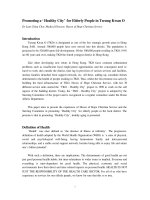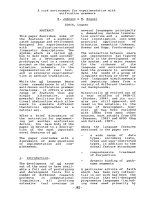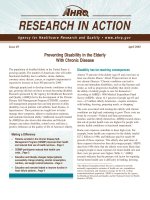CREATING A SUPPORTIVE ENVIRONMENT FOR ELDERLY WITH CHRONIC ILLNESS potx
Bạn đang xem bản rút gọn của tài liệu. Xem và tải ngay bản đầy đủ của tài liệu tại đây (35.5 KB, 7 trang )
1
CREATING A SUPPORTIVE ENVIRONMENT FOR ELDERLY WITH
CHRONIC ILLNESS
(Paper presented by Dr. Ho Po Ying, Amy, The Hong Kong Polytechnic University, at
the plenary session of the Healthy Ageing Convention on May 19, 2001, Hong Kong)
The need for a supportive environment
Supportive environments, both physical and social, are not only key determinants
of health but also essential conditions for healthy ageing. The World Health Organization
defines health broadly as a person’s physical, psychological and social well-being. The
notion of healthy age denotes a change in the perception of ageing, from the
preoccupation with illness management to the promotion of conditions that support health.
Indeed, the determinants of health include not only biological endowment and individual
behaviors but also physical and social environments (Beckingham & DuGas, 1993;
Roemer, 1985). Indeed, the lack of social support, the decline in traditional caring by
family members, environmental pollution, and deprived living conditions are factors
contributing to poor health status of the elderly (World Health Organization, 1998).
While healthy ageing is a universal goal for our elderly citizens, a supportive
environment, which ameliorates environmental hazards, is essential for health
maintenance and promotion among elderly with chronic illness. In Hong Kong, about
75% of the elderly population suffer from one or more chronic illness such as diabetes
mellitus, hypertension, and osteoporosis (Health and Welfare Bureau, 2000). Chronic
illness is one of the major causes of mortality and morbidity among the elderly, and
hence has a direct bearing on quality of life, as well as on the costs of health care. Local
studies have shown the adverse effect of chronic illness on the health status and social
functioning of our senior citizens (Chan & Leung, 1995; Chi & Lee, 1989). The
prevalence of chronic illness among our elderly citizens also has serious implications for
health care costs in Hong Kong. The elderly in Hong Kong consume a great proportion of
inpatient and ambulatory medical care (Hong Kong Census & Statistics Department,
1996; Lau & Wong, 1997). Multiple chronic illnesses and functional limitations are
factors contributing to unplanned hospital readmission among the elderly (Chu & Pei,
1999). To maintain the quality of life of elderly people with chronic illness, appropriate
changes in the physical and social aspects of the environment are deemed necessary.
Creating a supportive physical environment
Elderly people with multiple chronic illnesses are at greater risk of developing
functioning limitations and disabilities. The chance of home injury is likely to increase
for those who live alone or reside in poor living conditions. For the wheel chair-bound
elderly, access to community resources is, to a certain extent, hampered by the lack of
convenient transportation and accessible public facilities. Despite less favorable living
conditions, many elderly people prefer to live in the community rather than in institutions.
Thus, aging in place is a principle to be upheld as we attempt to create a supportive
environment for our senior citizens.
2
A basic requirement of a supportive physical environment is the provision of a
safe and accessible living environment for our elderly. Chronic illness, such as arthritis
and osteoporosis, will impose limitations on self-care and daily living activities. Elderly
with chronic illness can preserve their functional independence by appropriate use of
prosthetic aids or self-maintenance equipment, such as leg braces and wheel chairs. The
safety of a home environment can also be enhanced by means of home modification. By
installing handrails, smoke detectors, and other devices to minimize electrical and
tripping hazards, the likelihood of home accidents can be reduced. Finding of overseas
research suggest that one-third to one-half of home accidents can be prevented by means
of home modification and repair. For example, the risks of fall-related injuries could be
reduced by combining home modification and health education (Gillespie, Gillespie,
Cumming, Lamb & Rowe, 2000; National Resource and Policy Center on Housing and
Long-term care, 1998).
Aging in place does not imply that we should maintain the elderly in unsafe or
unsatisfactory living conditions for a prolonged period of time. In fact, the living
conditions of many elderly have been improved through urban renewal and
redevelopment of deprived communities. For elderly people who have resided in a
familiar neighborhood for many years, unexpected transition in living environment would
undermine their adjustment to the new living environment. The break in existing social
ties, and the lack of knowledge about community resources may give rise to a sense of
helplessness among these elderly. Overseas studies have shown that the feelings of
helplessness have a profound negative impact on mental health (Seligman, 1975; Fry,
1989). The situation would be aggravated if the new towns or communities were
designed to fit the needs of a young and able-bodied population. Environmental
psychologists have pointed out that a good fit between individual characteristics and their
environments is conducive to positive adjustments in late life. To this end, the principle
of universal design
1
should be adopted in future town planning and urban development
projects. For instance, community facilities should be easy to use, convenient and
accessible by elderly people with varying degrees of functional limitations and
disabilities.
In addition to a safe living environment, it is the responsibility of the government
to increase access to community resources by providing transportation and other
infrastructures for elderly with functional limitations. Action should also be taken to
reduce environmental pollution that is particularly detrimental to the health of our elderly
citizens.
Creating a supportive social environment
While a supportive physical environment is necessary for aging in place, a
supportive social environment is equally important. Elderly people with chronic illnesses,
demand a wide range of supports in order to avoid institutionalization and continue to
1
Universial design is an architectural design philosophy in which the needs of all environmental users
irrespective of their functional and physical abilities, are recognized in the natural ways
3
live in the community. In Hong Kong, over 10% of our elderly live alone and many more
reside only with their aging spouses (Health and Welfare Bureau, 2000). A certain
proportion of this population suffers from poor health, is in need of special attention, and
lack social support. Older women, in particular, often experience double jeopardy in
aging. Compared with their male counterparts, they are more likely to be widowed, living
alone and on a low income (Chappell & Havens, 1980). Over the years, there has been a
collaborative effort between the government and non-governmental organizations to
provide community-based care for our senior citizens, though these services are generally
not tailored-made for elderly people with chronic illnesses.
2
In view of the limitations
of these services, I believe that a supportive environment for the elderly can be enhanced
by improving the coordination and quality of community-based care. This can be done by
fostering a holistic and continuous approach, and strengthening social support through the
collaboration of formal and informal support networks.
Fostering a holistic and continuous care approach
In Hong Kong, efforts have been made to provide a supportive social environment
for elderly with chronic illness through community-based medical and social services. In
terms of medical services, community-based nursing services, Elderly Health Centers and
Community Geriatric Assessment Teams are some of the examples. However, due to
limited resources, these services are beyond the reach of many elderly. On the other hand,
many of the chronically ill elderly have benefited from community-based social and
supportive services, including home help services, elderly outreaching service, and
support teams for the elderly based on multi-service elderly centers. Despite these efforts
to provide community support to the elderly, local figures indicate that only a small
percentage of the elderly are able to receive community-based geriatric care (Census and
statistics Department, 1996). Although many community-based social services are
generally well received by the service recipients, a great deal of time has been spent by
the service providers to coordinate different service agencies and social programs. On
the other hand, feedback from front-line paid care workers and volunteers reflected that
the linkage between hospitals and social welfare agencies was inadequate (Department of
Social Work and Social Administration, HKU, 1998).
Indeed, the varying needs of elderly with chronic illness demand a
multidisciplinary collaborative approach among different professionals and organizations
in the community. Overseas experiences have shown that community-based, and
coordinated medical and social services enable elderly patients to receive continuous and
appropriate care (Bernabei et al., 1998; Eng, Pedulla, Eleazer, McCann, & Fox, 1997;
Guagenti-Tax, DiLorenze, Tenteromano, LaRocca & Smith, 2000). These community-
based integrated models of geriatric care have been successful in the United States, where
hospital readmission rate was reduced and elderly people were able to avoid premature or
unnecessary institutionalization (Eng et. al., 1997). Other home and community based
long term care models also showed increased life satisfaction and social interactions, as
well as reduced unmet needs among the elderly (Guagenti-Tax et al., 2000; Weissert,
Cready, & Pawelak, 1988). To ensure the provision of continuous and holistic care for
2
It should be noted that “Enhanced Home Care” is a newly developed service that targets at citizens with
nursing needs.
4
our elderly citizens who move frequently between different locus of care
3
, reform
measures should be taken to coordinate geriatric medical and social service sectors within
the same community or district. For example, the coordination between hospitals and
non-government organizations could be strengthened through shared clients’ records and
simplified referral procedures. As demonstrated by overseas experience, a case-manager
approach could ensure continuity of care for elderly people with multifaceted service
needs. Such people often get lost in multiple service systems (Rothman & Sager, 1998)
Enhancing quality of social support through the collaboration of formal and informal
support networks
In my view, a supportive social environment can be created for the chronically ill
elderly through both formal and informal social support systems
4
. The reciprocal
interactions between the elderly and their social environment are likely to influence their
adaptability, access to information, and motivation to seek help from others. Formal and
informal social supports often complement each other, depending on the nature of service
being provided. For services that require long-term commitment, flexibility in the timing
of responses, and familiarity with the care recipient are best handled by kin or informal
social networks (Litwak, 1985). By contrast, formal supports are more appropriate when
professional knowledge and referral are needed (Penning, 1995; Wan, 1987; Wolinsky &
Johnson, 1991). By providing instrumental, emotional, and informational support,
members of both the formal and informal support networks form a convoy of social
support for elderly people with chronic illness.
Existing community-based social care programs in Hong Kong have a strong
emphasis to providing instrumental social support to the elderly, such as direct assistance
with daily living activities, meal delivery and escort services. While services from paid
care workers are essential for maintaining daily functioning, they are not the most
appropriate source of care in situations involving unpredictable and idiosyncratic needs.
Comparatively speaking, informal support from kin, friends, and neighbors is more
responsive to crisis assistance or providing help during illness. Thus, programs should be
developed to equip informal caregivers with skills in responding to crisis situations such
as home injury and seizure.
The effects of chronic illness on the psychological well being of the elderly cannot
be underestimated – psychological effects are no less worthy or our attention than the
physiological effects. The decline of functional levels and the loss of vitality associated
with chronic illness, and the experience of stressful life events often leads to depression
among the elderly. In Hong Kong, prolonged illness, mood disorder, and lack of social
support are identified as the major risk factors of elderly suicide (Report of The Elderly
3
Due to the changes in physical and medical conditions, many elderly have to change the venues of care
often. For example, about 13.5% to 25% of the elderly patients move frequently from home to hospitals
within a short period of time (Chu & Pei, 1999; The Hong Kong Hospital Authority, 1996).
4
Informal social support refers to support from one’s informal social network such as family and friends.
Formal social support refers to support from the government and non-governmental organizations,
including medical and social services.
5
Commission, 2000). Overseas studies have shown that perceived social support has the
potentials to buffer the negative effects of stressful life events (Cohen and Wills, 1985;
Wethington & Kessler, 1986). At present, volunteers recruited by non-government
organizations have been providing home-visitation and other support programs for the
elderly. Recipients of volunteer home visitation reported improvement in well-being and
reduction in their feelings of loneliness (Department of Social Work and Social
Administration, HKU, 1998). In my opinion, home visitation is likely to increase the
sense of self-worth and positive attitude among the elderly if the visitors are able to build
up trustful relationship with the elderly and possess a certain level of skills in providing
emotional support. A local study has shown that a natural locality-based social support by
neighbors has generated very positive psychological effects on singleton elderly (Yip,
1994). By encouraging reciprocal social support with their neighbors, disabled singleton
elderly become normal functioning members of the community, rather than passive
service recipients.
Knowledge and information relating to community resources are important for the
elderly and help them live independently in the community. It has been suggested that a
person’s social network is not only a major channel of advice and support during illness,
but also the main source for developing health beliefs, attitudes and knowledge about
medical options. Social support networks also function as conduits for information on a
wide range of social resources. Thus, informational support for the elderly should be
strengthened in community-based social care programs. Formal service providers, such
as medical professionals and social workers, are typical agents for disseminating
information about community resources. Family members, paid care workers and
volunteers could be enlisted to provide informational support to the elderly through
frequent contacts and home visits. Given appropriate and adequate training, they would
be in a better position to provide information on existing medical and social services in
the community, promoting healthy lifestyles, encouraging compliance with medical
regimens, or facilitating communication with health care professionals. All these support
systems are important for the chronically ill elderly who wish to make informed choices
in achieving healthy aging.
Conclusion
To promote healthy ageing among the elderly with chronic illness, we need the
collaborative efforts of government agencies, non-government organizations, and the
community as a whole to carry out interventions that focus on meeting individual needs
and enhancing the quality of life. By providing a supportive environment, we would
encourage aging in place while preserving the life-styles and preferences of our senior
citizens. In the process of achieving these goals, we should be conscientious in
maintaining a goodness of fit between the needs of the elderly and the amount of support
to be provided. An optimal amount of support is conducive to better adjustment in late
life, while too much support may hamper the ability of the elderly to preserve their
functional independence. A final but important point, I believe, is that our senior citizens
should take center stage in setting the direction for healthy aging. Their voices should be
heard and their choices must be respected fully.
6
Bibliography
Beckingham, A.C. & DuGas, B.W. (1993). Promoting Healthy Aging – A Nursing and Community
Perspective. St. Louis: Mosby-Year Book, Inc.
Bernanbei, R., Landi, T., Gambassi, G., Sgadari, A., Zuccala, Mor, V., Rubenstein, L.Z., Carbonin, P.,
(1998). Reamdomized Trail of Impact of Model of Integrated Care and Case Management for Older People
living in the Community. British Medical Journal. 316 (7174), p 1348-1351.
Chan, C.M. & Leung, M.F. (1995). Depression and Physical Health amongst the Chinese Elderly in Hong
Kong. Hong Kong Journal of Gerontology. 9 (1), 49-55.
Chappell, N., & Havens, B. (1980). Old and Female: Testing the double jeopardy hypothesis. Sociological
Quarterly. 21(1), 157-171.
Chi, I. & Lee, J.J. (1989). A Health survey of the elderly in Hong Kong. Hong Kong: Department of Social
Work and Social Administration. University of Hong Kong.
Cohen, S.C. & Wills, T.A. (1985). Stress, Social Support & the Buffering Hypothesis. Psychological
Bulletin, 98(2), 310-357.
Chu, L.W. & Pei, C.K.W. (1999). Risk Factors for Early Emergency Hospital Readmission in Elderly
Medical Patients. Hong Kong Journal of Gerontology, 45, 220-226.
Department of Social Work and Social Administration, University of Hong Kong (1998). Report of an
Evaluative Study on the Social Networking for the Elderly (SNE) project. Hong Kong: University of Hong
Kong.
Eng, C., Pedullar, J., Eleazer, G.P., McCann, R. & Fox, N. (1997). Program of All-inclusive Care for the
Elderly (PACE): An Innovative Model of Integrative Geriatric Care and Financing. Journal of the
American Geriatrics Society. 45 (2), 223-232.
Fry, P.S (1989). Perceptions of vulnerability and controls in old age: A critical reconstruction. In P.S. Fry
(Ed.), Psychological perspectives of helplessness and control in the elderly. (pp.1-39). Amsterdam: North
Holland.
Gillespie, L.D., Gillespie, W.J., Cumming, R., Lamb, S.E. & Rowe, B.H.( 2000) Interventions for
preventing falls in the elderly. Cochrane Database of Systematic Reviews.
Guagenti-Tax, E.M.; Dilorenzo, TA.; Tenteromano, L.; LaRocca, NG. & Smith, CR. (2000). Impact of a
Comprehensive Long-term Care program on Caregivers and Persons with Multiple Sclerosis. International
Journal of MS Care, 2(1), 5-21.
Health & Welfare Bureau (2000). Survey on the Socio-demographic, Health and Economic Profiles of
Older People and the Soon to Old People. Hong Kong: HKSAR.
Hong Kong Census and Statistics Department, 1996 Population By-census. Hong Kong: Hong Kong
Special Administrative Region.
Hong Kong Hospital Authority (1996). Special Review on Unplanned Readmissions. Unpublished data.
Lau, M.K., & Wong, L.C. (1997). Report of the Working Group on Care for the Elderly. Hong Kong:
Provisional Legislative Council.
Litwak, E. (1985). Helping the Elderly. New York: Guilford Press.
7
Ngai, M.H. & Cheung, C.K. (1998). A Study of the Effectiveness of the Project of Social Network for the
Elderly in the Southern District. Hong Kong: Department of Applied Social Studies, City University of
Hong Kong & Aberdeen Kai-fong Welfare Association Social Service Centre.
Penning, M. J. (1995). Health, Social Support, and the Utilization of Health Services Among Older Adults.
Journal of Gerontology, 50B(5), S330-S339.
Roemer, M.I. (1985). National Strategies for Health Care Organization: A World Overview. Ann Arbor:
Health Administration Press.
Rothman, J. & Sager, J.S. (1998) Case Management (2
nd
Edition). MA: Allyn & Bacon, Prentice-Hall Inc.
Seligman, M.E.P. (1975). Helplessness: On depression, development, and death. San Francisco: W.H.
Freeman.
The Elderly Commission (2001) Report on Healthy Ageing. Hong Kong : Hong Kong Government
Printer.’
Wan, T. H. (1987). Functionally Disabled Elderly: Health Status, Social Support and Use of Health
Services. Research on Aging, 9(1), 61-78.
Weissert, W.G., Gready, C.M. & Pawelak, J.E. (1988). The Past and the Future of Home-and-Community-
based Long Term Care. The Milbank Quarterly. 66 (2), 309-389.
Wethington, E & Kessler, R.C. (1986). Perceived Support, Received Support, and Adjustment to Stressful
Life Events. Journal of Health and Social Behaviours. 27(March), 78-89.
Wolinsky, F.D. and Johnson, R.J. (1991). The use of Health Services among Older Adults. Journal of
Gerontology: Social Sciences 46 S345-357.
World Health Organization (1998). The World Health Report 1998. Geneva, Switzerland: WHO.
Yip, K.S. (1994). A Report of the informal community care project for disabled elderly in Sau Mau Ping
Estate. In Stopp G.H. (eds). International Perspectives on HealthCare for the Elderly. New York: Perter
Lang. P53-67.
Web-sites
National Resource and Policy Centre on Housing and Long-term Care
agingconvention3.doc









